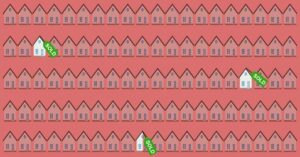The first half of 2023 saw only 14 out of every 1,000 homes in the U.S. change hands — the lowest turnover rate in at least a decade, according to Redfin.
The figure is down from 19 homes in 1,000 during the first half of 2019, a rate that is generally considered typical for the modern-day housing market, per Redfin data. A more active market would have a rate closer to 40 or 50 out of every 1,000 homes switching ownership.
The turnover rate has slid the most in suburban markets, where only 16 out of every 1,000 single-family houses with at least four bedrooms have changed hands from January to June of this year. That’s down from 24 in 1,000 during the same six-month stretch in 2019. Put another way, buyers looking for large suburban houses have roughly 33% fewer properties to choose from than four years ago.
But small, urban single-family homes, which were already rare, have become the hardest to find, with a scant 11 in 1,000 two- and three-bedroom houses in urban areas changing hands in the first half of this year. That’s down from 14 in 1,000 in 2019.
“New listings normally hit the market on Thursdays, and I have buyers who are excitedly checking their Redfin app Thursday mornings, only to find nothing new,” said Heather Mahmood-Corley, a Redfin agent in Phoenix. “That goes for buyers in every price range in every type of neighborhood, but what people want most are those move-in-ready, midsized homes in neighborhoods with highly rated schools. Those are hardest to find because for people to buy one, someone needs to sell one. That’s not happening, because so many of those homeowners have low mortgage rates.”
Indeed, the pandemic-era homebuying boom not only put many people in new homes (and into a window where they’re not looking to move again so soon) but also locked them into interest rates that are vastly below those offered currently. This intensified a shortage of resale listings that was already undersupplied prior to the pandemic. Consider that, in 2018, Freddie Mac estimated that the market needed some 2.5 million more homes to be built for demand to be met. Add in the rise of remote- and hybrid-work policies, along with the growth of investor home purchases, and it’s easy to see the recipe for the current dearth of inventory that’s created this year’s record-low turnover rate.
The aforementioned “lock-in effect” has been especially exacerbated as of late due to the volatile interest rate environment, said Taylor Marr, Redfin’s deputy chief economist.
“The quick increase in mortgage rates created an uphill battle for many Americans who want to buy a home by locking up inventory and making the homes that do hit the market too expensive. The typical home is selling for about 40% more than before the pandemic,” Marr noted.
He added that rates closer to 5% would mark a big turning point in the affordability crisis, not only by bringing monthly payments down but also by freeing up inventory. Making it easier on homebuilders from a regulatory standpoint would go a long way too, he added.
“Building more housing is imperative, and federal and local governments can help by reforming zoning and making the building process easier,” Marr said. “Financial incentives, like reducing transfer taxes for home sellers and subsidizing major moves with tax breaks, would also add to supply.”





